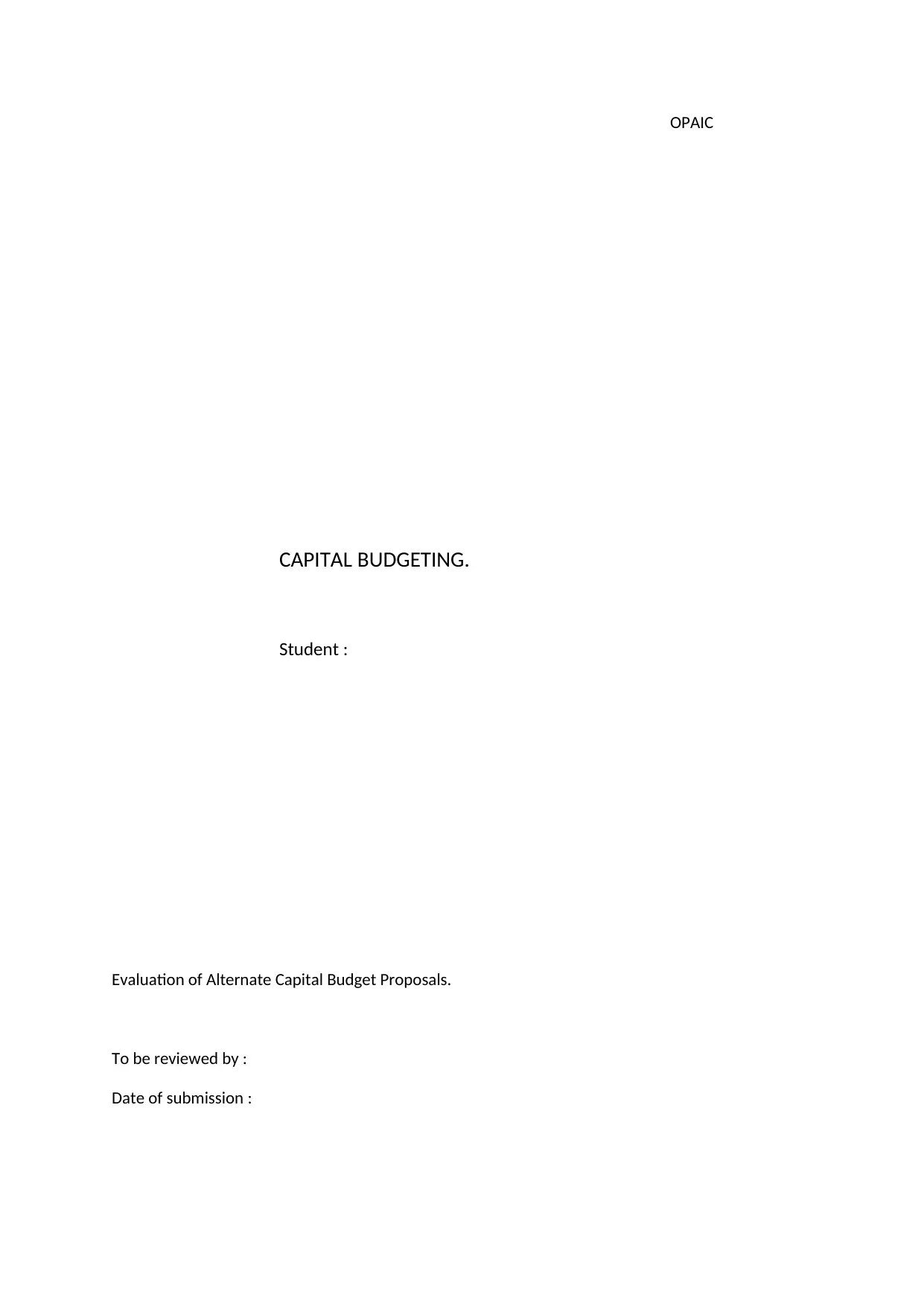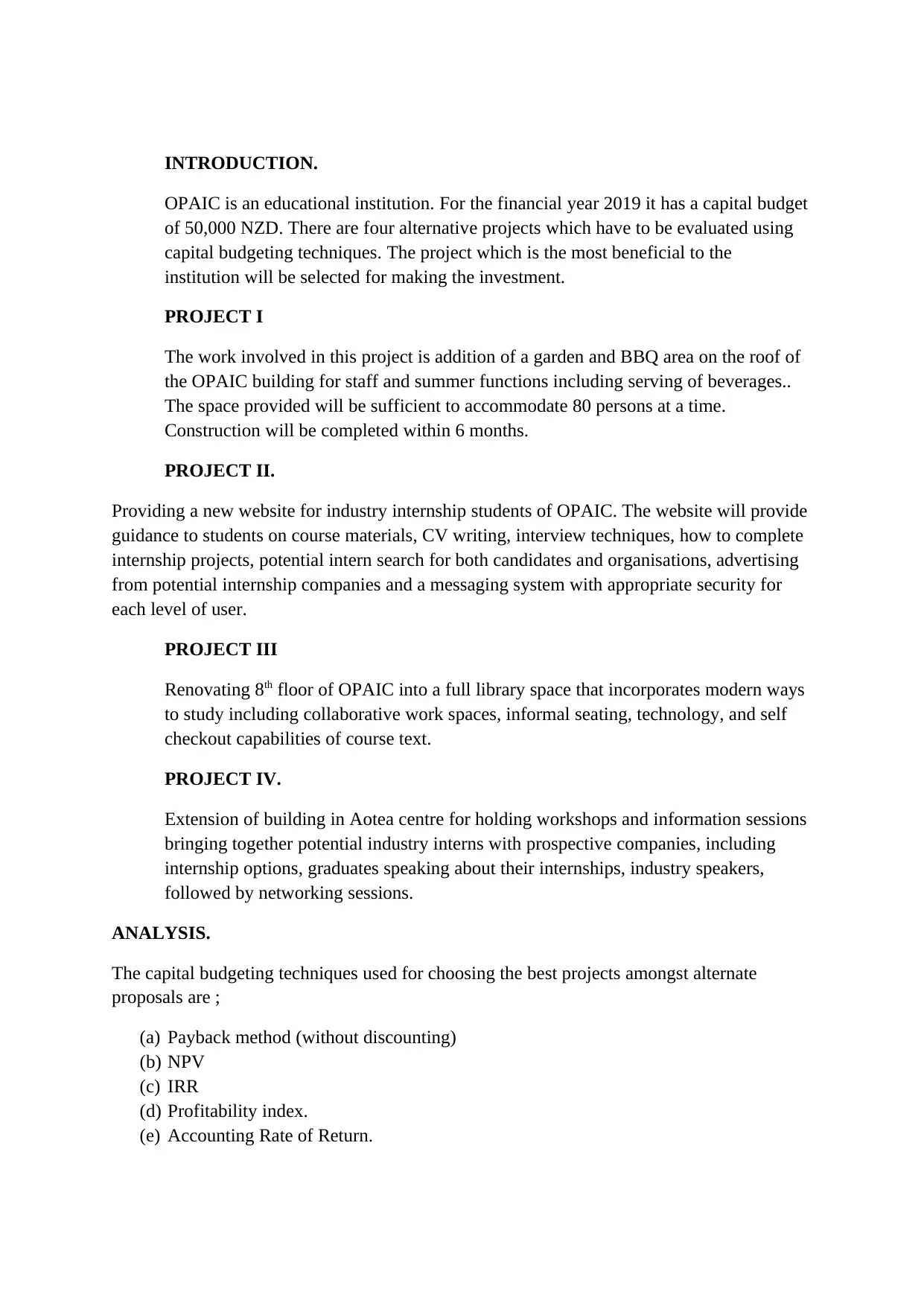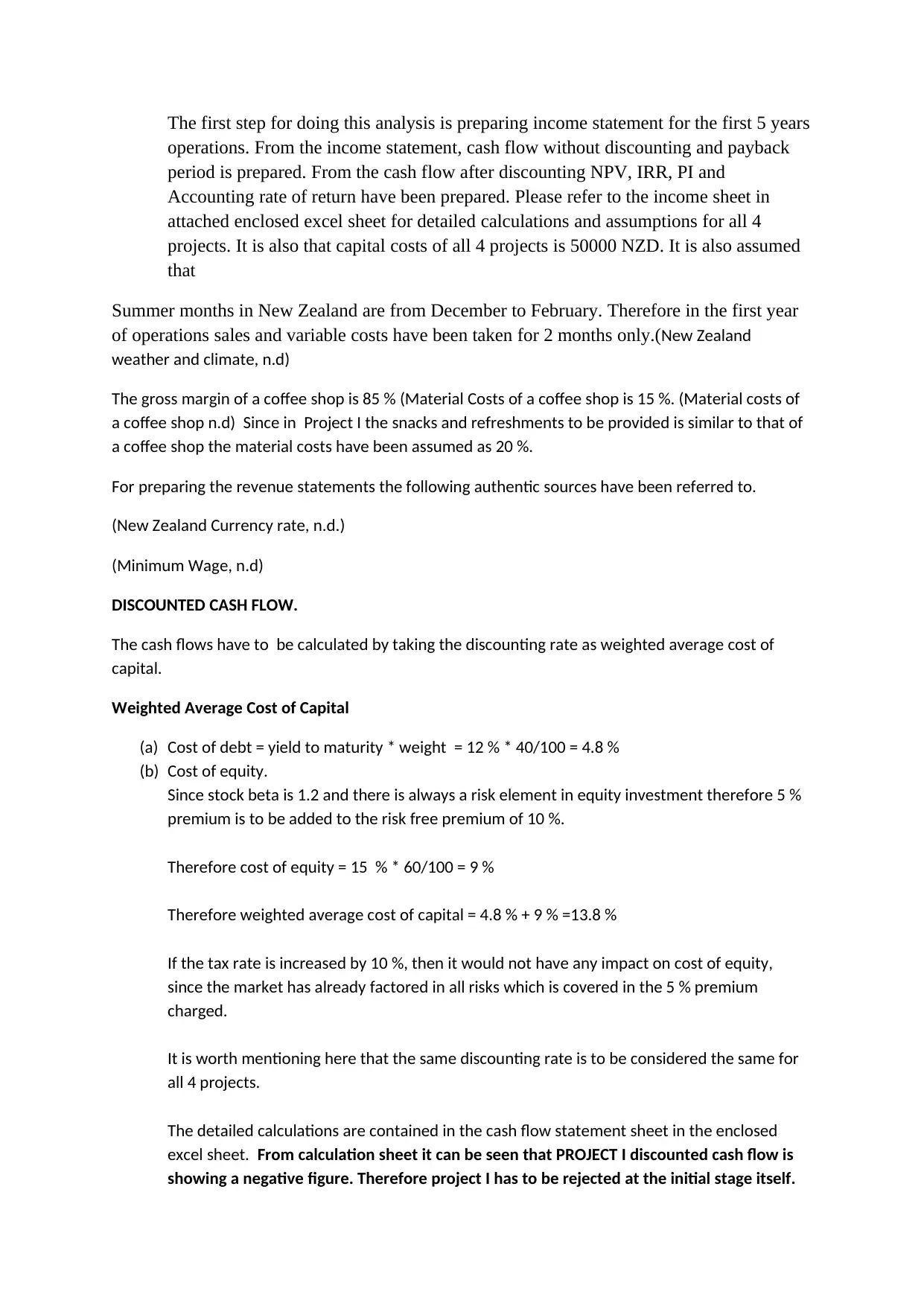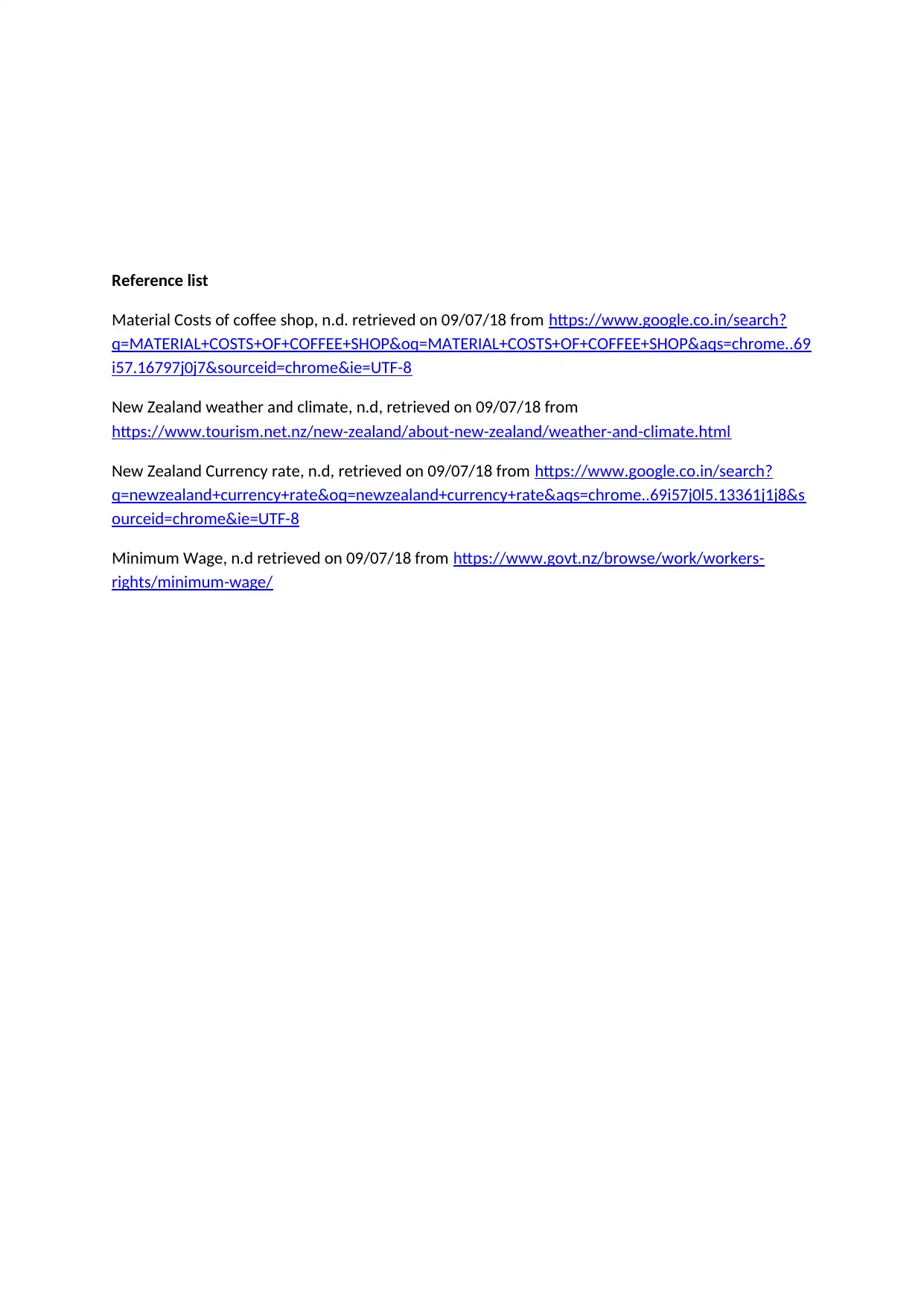Financial Analysis: Evaluation of OPAIC Capital Budgeting Projects
VerifiedAdded on 2023/06/10
|4
|847
|339
Project
AI Summary
This assignment analyzes four capital budgeting projects for OPAIC, an educational institution, with a capital budget of 50,000 NZD for the financial year 2019. The projects include adding a garden and BBQ area, providing a new website for internship students, renovating a floor into a library, and extending a building for workshops. The analysis employs capital budgeting techniques such as payback method, NPV, IRR, profitability index, and accounting rate of return. The assignment includes the preparation of income statements, cash flow calculations, and the determination of a weighted average cost of capital to discount cash flows. Project I is rejected due to a negative discounted cash flow. Detailed calculations and assumptions are provided in an enclosed Excel sheet, and relevant sources are referenced.

OPAIC
CAPITAL BUDGETING.
Student :
Evaluation of Alternate Capital Budget Proposals.
To be reviewed by :
Date of submission :
CAPITAL BUDGETING.
Student :
Evaluation of Alternate Capital Budget Proposals.
To be reviewed by :
Date of submission :
Paraphrase This Document
Need a fresh take? Get an instant paraphrase of this document with our AI Paraphraser

INTRODUCTION.
OPAIC is an educational institution. For the financial year 2019 it has a capital budget
of 50,000 NZD. There are four alternative projects which have to be evaluated using
capital budgeting techniques. The project which is the most beneficial to the
institution will be selected for making the investment.
PROJECT I
The work involved in this project is addition of a garden and BBQ area on the roof of
the OPAIC building for staff and summer functions including serving of beverages..
The space provided will be sufficient to accommodate 80 persons at a time.
Construction will be completed within 6 months.
PROJECT II.
Providing a new website for industry internship students of OPAIC. The website will provide
guidance to students on course materials, CV writing, interview techniques, how to complete
internship projects, potential intern search for both candidates and organisations, advertising
from potential internship companies and a messaging system with appropriate security for
each level of user.
PROJECT III
Renovating 8th floor of OPAIC into a full library space that incorporates modern ways
to study including collaborative work spaces, informal seating, technology, and self
checkout capabilities of course text.
PROJECT IV.
Extension of building in Aotea centre for holding workshops and information sessions
bringing together potential industry interns with prospective companies, including
internship options, graduates speaking about their internships, industry speakers,
followed by networking sessions.
ANALYSIS.
The capital budgeting techniques used for choosing the best projects amongst alternate
proposals are ;
(a) Payback method (without discounting)
(b) NPV
(c) IRR
(d) Profitability index.
(e) Accounting Rate of Return.
OPAIC is an educational institution. For the financial year 2019 it has a capital budget
of 50,000 NZD. There are four alternative projects which have to be evaluated using
capital budgeting techniques. The project which is the most beneficial to the
institution will be selected for making the investment.
PROJECT I
The work involved in this project is addition of a garden and BBQ area on the roof of
the OPAIC building for staff and summer functions including serving of beverages..
The space provided will be sufficient to accommodate 80 persons at a time.
Construction will be completed within 6 months.
PROJECT II.
Providing a new website for industry internship students of OPAIC. The website will provide
guidance to students on course materials, CV writing, interview techniques, how to complete
internship projects, potential intern search for both candidates and organisations, advertising
from potential internship companies and a messaging system with appropriate security for
each level of user.
PROJECT III
Renovating 8th floor of OPAIC into a full library space that incorporates modern ways
to study including collaborative work spaces, informal seating, technology, and self
checkout capabilities of course text.
PROJECT IV.
Extension of building in Aotea centre for holding workshops and information sessions
bringing together potential industry interns with prospective companies, including
internship options, graduates speaking about their internships, industry speakers,
followed by networking sessions.
ANALYSIS.
The capital budgeting techniques used for choosing the best projects amongst alternate
proposals are ;
(a) Payback method (without discounting)
(b) NPV
(c) IRR
(d) Profitability index.
(e) Accounting Rate of Return.

The first step for doing this analysis is preparing income statement for the first 5 years
operations. From the income statement, cash flow without discounting and payback
period is prepared. From the cash flow after discounting NPV, IRR, PI and
Accounting rate of return have been prepared. Please refer to the income sheet in
attached enclosed excel sheet for detailed calculations and assumptions for all 4
projects. It is also that capital costs of all 4 projects is 50000 NZD. It is also assumed
that
Summer months in New Zealand are from December to February. Therefore in the first year
of operations sales and variable costs have been taken for 2 months only.(New Zealand
weather and climate, n.d)
The gross margin of a coffee shop is 85 % (Material Costs of a coffee shop is 15 %. (Material costs of
a coffee shop n.d) Since in Project I the snacks and refreshments to be provided is similar to that of
a coffee shop the material costs have been assumed as 20 %.
For preparing the revenue statements the following authentic sources have been referred to.
(New Zealand Currency rate, n.d.)
(Minimum Wage, n.d)
DISCOUNTED CASH FLOW.
The cash flows have to be calculated by taking the discounting rate as weighted average cost of
capital.
Weighted Average Cost of Capital
(a) Cost of debt = yield to maturity * weight = 12 % * 40/100 = 4.8 %
(b) Cost of equity.
Since stock beta is 1.2 and there is always a risk element in equity investment therefore 5 %
premium is to be added to the risk free premium of 10 %.
Therefore cost of equity = 15 % * 60/100 = 9 %
Therefore weighted average cost of capital = 4.8 % + 9 % =13.8 %
If the tax rate is increased by 10 %, then it would not have any impact on cost of equity,
since the market has already factored in all risks which is covered in the 5 % premium
charged.
It is worth mentioning here that the same discounting rate is to be considered the same for
all 4 projects.
The detailed calculations are contained in the cash flow statement sheet in the enclosed
excel sheet. From calculation sheet it can be seen that PROJECT I discounted cash flow is
showing a negative figure. Therefore project I has to be rejected at the initial stage itself.
operations. From the income statement, cash flow without discounting and payback
period is prepared. From the cash flow after discounting NPV, IRR, PI and
Accounting rate of return have been prepared. Please refer to the income sheet in
attached enclosed excel sheet for detailed calculations and assumptions for all 4
projects. It is also that capital costs of all 4 projects is 50000 NZD. It is also assumed
that
Summer months in New Zealand are from December to February. Therefore in the first year
of operations sales and variable costs have been taken for 2 months only.(New Zealand
weather and climate, n.d)
The gross margin of a coffee shop is 85 % (Material Costs of a coffee shop is 15 %. (Material costs of
a coffee shop n.d) Since in Project I the snacks and refreshments to be provided is similar to that of
a coffee shop the material costs have been assumed as 20 %.
For preparing the revenue statements the following authentic sources have been referred to.
(New Zealand Currency rate, n.d.)
(Minimum Wage, n.d)
DISCOUNTED CASH FLOW.
The cash flows have to be calculated by taking the discounting rate as weighted average cost of
capital.
Weighted Average Cost of Capital
(a) Cost of debt = yield to maturity * weight = 12 % * 40/100 = 4.8 %
(b) Cost of equity.
Since stock beta is 1.2 and there is always a risk element in equity investment therefore 5 %
premium is to be added to the risk free premium of 10 %.
Therefore cost of equity = 15 % * 60/100 = 9 %
Therefore weighted average cost of capital = 4.8 % + 9 % =13.8 %
If the tax rate is increased by 10 %, then it would not have any impact on cost of equity,
since the market has already factored in all risks which is covered in the 5 % premium
charged.
It is worth mentioning here that the same discounting rate is to be considered the same for
all 4 projects.
The detailed calculations are contained in the cash flow statement sheet in the enclosed
excel sheet. From calculation sheet it can be seen that PROJECT I discounted cash flow is
showing a negative figure. Therefore project I has to be rejected at the initial stage itself.
⊘ This is a preview!⊘
Do you want full access?
Subscribe today to unlock all pages.

Trusted by 1+ million students worldwide

Reference list
Material Costs of coffee shop, n.d. retrieved on 09/07/18 from https://www.google.co.in/search?
q=MATERIAL+COSTS+OF+COFFEE+SHOP&oq=MATERIAL+COSTS+OF+COFFEE+SHOP&aqs=chrome..69
i57.16797j0j7&sourceid=chrome&ie=UTF-8
New Zealand weather and climate, n.d, retrieved on 09/07/18 from
https://www.tourism.net.nz/new-zealand/about-new-zealand/weather-and-climate.html
New Zealand Currency rate, n.d, retrieved on 09/07/18 from https://www.google.co.in/search?
q=newzealand+currency+rate&oq=newzealand+currency+rate&aqs=chrome..69i57j0l5.13361j1j8&s
ourceid=chrome&ie=UTF-8
Minimum Wage, n.d retrieved on 09/07/18 from https://www.govt.nz/browse/work/workers-
rights/minimum-wage/
Material Costs of coffee shop, n.d. retrieved on 09/07/18 from https://www.google.co.in/search?
q=MATERIAL+COSTS+OF+COFFEE+SHOP&oq=MATERIAL+COSTS+OF+COFFEE+SHOP&aqs=chrome..69
i57.16797j0j7&sourceid=chrome&ie=UTF-8
New Zealand weather and climate, n.d, retrieved on 09/07/18 from
https://www.tourism.net.nz/new-zealand/about-new-zealand/weather-and-climate.html
New Zealand Currency rate, n.d, retrieved on 09/07/18 from https://www.google.co.in/search?
q=newzealand+currency+rate&oq=newzealand+currency+rate&aqs=chrome..69i57j0l5.13361j1j8&s
ourceid=chrome&ie=UTF-8
Minimum Wage, n.d retrieved on 09/07/18 from https://www.govt.nz/browse/work/workers-
rights/minimum-wage/
1 out of 4
Related Documents
Your All-in-One AI-Powered Toolkit for Academic Success.
+13062052269
info@desklib.com
Available 24*7 on WhatsApp / Email
![[object Object]](/_next/static/media/star-bottom.7253800d.svg)
Unlock your academic potential
Copyright © 2020–2025 A2Z Services. All Rights Reserved. Developed and managed by ZUCOL.





